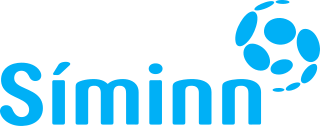
CANTAT-3 was the third Canadian transatlantic telecommunications cable, in regular operation from 1994 to 2010, carrying 3 x 2.5 Gbit/s between Canada and Europe. It branches to both Iceland and the Faroe Islands. It is out of normal service for international bandwidth and is currently operated by Føroya Tele to service oil platforms in the North Sea.
Telecommunications in Iceland is a diversified market.
Icelandair is the flag carrier of Iceland, with its corporate head office on the property of Reykjavík Airport in the capital city Reykjavík. It is part of the Icelandair Group and operates to destinations on both sides of the Atlantic Ocean from its main hub at Keflavík International Airport. The geographical position of Iceland is convenient for one-stop transatlantic flights via the Atlantic Bridge route, which is one pillar of the airline's business strategy, along with traffic to, from, and within the country.

Vágar Airport is the only airport in the Faroe Islands, and is located 1 NM east of the village of Sørvágur, on the island of Vágar. Due to the Faroe Islands' status as a self-governing territory, the airport is not subject to the rules of the European Union. It is the main operating base for Faroese national airline Atlantic Airways and, for a brief period during 2006, was also the base for the low-cost airline FaroeJet.

Keflavík Airport, also known as Reykjavík–Keflavík Airport, is the largest airport in Iceland and the country's main hub for international transportation. The airport is 1.7 nautical miles west of Keflavík and 50 km (30 mi) southwest of Reykjavík. The airport has three runways, two of which are in use, and the airport area is about 25 km2 (10 sq mi). Most international journeys to or from Iceland pass through this airport.

Síminn hf., previously named Landssíminn and Póstur og Sími, is an Icelandic telecommunications company. It offers communication services for both private and corporate clients, including mobile (2G/3G/4G/5G), landline (VoIP/POTS), Internet (ADSL/VDSL/FTTH) and IPTV services. Síminn also operates multiple TV channels and streaming services. Síminn is listed on the Icelandic stock exchange.
Apollo is an optical submarine communications cable system crossing the Atlantic Ocean, owned by Apollo Submarine Cable System Ltd. It consists of 2 segments North and South, creating two fully diverse transatlantic paths.

Akureyri Airport is a single-runway international airport in Akureyri, Iceland, 3 kilometres south of the town centre. Icelandair and Norlandair link the airport with several domestic locations, as well as easyJet, Edelweiss Air and Transavia serving seasonal international destinations. In the period 2009 to 2024 the airport has seen numerous improvements and expansions to better equip the airport for international flights. A new expanded passenger terminal is currently under construction, due to be completed by 2024.
In a hierarchical telecommunications network, the backhaul portion of the network comprises the intermediate links between the core network, or backbone network, and the small subnetworks at the edge of the network.

Telecommunications engineering is a subfield of electronics engineering which seeks to design and devise systems of communication at a distance. The work ranges from basic circuit design to strategic mass developments. A telecommunication engineer is responsible for designing and overseeing the installation of telecommunications equipment and facilities, such as complex electronic switching systems, and other plain old telephone service facilities, optical fiber cabling, IP networks, and microwave transmission systems. Telecommunications engineering also overlaps with broadcast engineering.
Bit-stream access refers to the situation where a wireline incumbent installs a high-speed access link to the customer's premises and then makes this access link available to third parties, to enable them to provide high-speed services to customers. This type of access does not entail any third-party access to the copper pair in the local loop.

Iceland is among the top countries in the world in terms of Internet deployment and use. 99.68% of Icelanders used in the internet in 2021.
SHEFA-2 is an undersea communication cable linking the Faroe Islands to mainland Scotland via the Northern Isles. It is named after the route on which it is being deployed (SHEtland-FAroes) and succeeds an earlier cable called SHEFA-1 on the same route.

Greenland Connect is a submarine communications cable system that connects Canada, Greenland, and Iceland. The cable contains two fibre pairs specified for 128*10 Gbit/s wavelength each. Initial lit capacity is 1*10 Gbit/s for each fibre pair. Two additional 10 Gbit/s Wavelength were installed in the summer of 2010. The cable has cable landing points at:

The DANICE submarine communications cable system transits 2250 km of the North Atlantic Ocean and the North Sea to connect Iceland and Denmark. It consists of four fibre pairs, capable of carrying in total up to 36.4 Tbit/s of data using 100Gbit/s coherent wavelength technology available in 2013. The cable went into operation in November 2009 and has had no submarine faults. The operator of the cable is Farice ehf. The complementary cable is FARICE-1. DANICE has cable landing points at:
Saint Helena, Ascension and Tristan da Cunha is a British Overseas Territory in the South Atlantic, consisting of the island of Saint Helena, Ascension Island and the archipelago of Tristan da Cunha including Gough Island. Their communications provision includes dedicated radio and television stations, and telecommunications infrastructure.
Farice is a telecommunications service provider operating in Iceland. The company offers Internet transit, MPLS VPN, DWDM and SDH services and offers only international connectivity. The company operates mainly as a carrier for service providers, data center customers and data center service providers.
Føroya Tele P/f (FT) is the public telecommunications company in the Faroe Islands. It is one of the largest companies in the country with 230 employees and an annual turnover of around 40 million euros. The head office is in Tórshavn Municipality.
Events in the year 1906 in Iceland.








